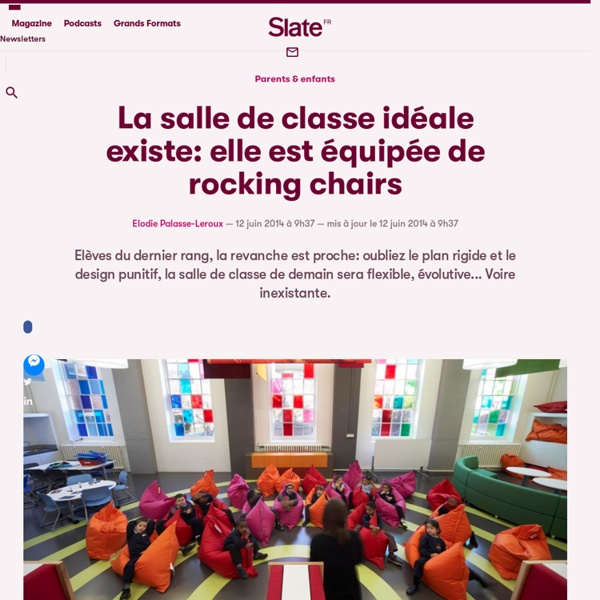



http://www.slate.fr/story/88293/salle-de-classe-ideale-rocking-chairs
Related: Recherches en Sciences de l'éducation • Outils pédagogiques • Lieux • Différenciation - Classe inversée - Evaluation - PédagogieCreativity Becomes an Academic Discipline Photo IT BOTHERS MATTHEW LAHUE and it surely bothers you: enter a public restroom and the stall lock is broken. Fortunately, Mr. Lahue has a solution. It’s called the Bathroom Bodyguard. Standing before his Buffalo State College classmates and professor, Cyndi Burnett, Mr. Hazelwood School GM + AD Architects pursued the Hazelwood project with a commitment to building knowledge and capacity on a building that would work with children with a very complex range of abilities. Most extant examples are schools serving the needs of children with visual limitations, or hearing limitations, or cognitive issues or physical limitations. In this case, the design would need to meet the needs and enhance the independence of children with a mix of all of these issues.
How to Apply Design Thinking in Class, Step By Step By Anne Stevens For educators ready to try the idea of design thinking, you’ll be glad to know it does not require extensive transformation of your classroom. That said, it can be a transformative experience for all involved. Here, we try to answer your questions about integrating different components of a design learning experience into familiar, pre-existing scenarios that play out in every school. Can my classroom become a space of possibility? Five-Minute Film Festival: Classroom Makeovers to Engage Learners Most educators have little choice about the (usually) over-crowded, (often) unappealing rooms they teach in -- but they intuitively know that the spaces children spend their time in can have an effect on how they learn. I've gathered a collection of videos to explore the questions: How important is environment to learning? And what small changes can you make in seating, organization, lighting, and decor to build your own space into a better place to teach and learn? Video Playlist: Innovative Learning Spaces Watch the player below to see the whole playlist, or view it on YouTube.
Best Practices in Educational Facilities Investments Exemplary design categories: multi-sensory environment, outdoor spaces, safety, special needs provision How the facility meets the needs of education and communities: The ambition of this school for children and young people with sensory impairments was to create a challenging and stimulating environment for all. Varied wall and floor surface textures and built-in navigational aids - such as trail rails, varied ceiling heights, and the print, Braille, moon and graphical signage - help children to navigate around the building independently. The main school building is a single-storey “s” shape structure that reduces the perceived scale of the school and makes it less intimidating and more welcoming to small children.
Are flexible learning environments working in NZ schools? Modern classrooms are closely linked to innovative teaching methods and deeper learning, research in New Zealand and Australia has found. Photo: RNZ The ongoing, four-year University of Melbourne study surveyed all New Zealand schools and about 4000 in Australia and receives funding from New Zealand's Ministry of Education. Lead researcher Wesley Imms said in both countries schools were building new classrooms that featured large open spaces with small rooms and moveable walls. Let's Keep Learning (Even When It's Less Convenient) - Leading, Learning, Questioning December is nearly upon us, and as we work through the last few weeks of the semester in what can often feel like a sprint to the finish, I think it’s important for us to remember that if we expect our students to continue their learning, it only makes sense that we should lead in that way as well. That’s easier said than done (for both students and for educators), but it’s a worthwhile goal nonetheless. Goals like this don’t just happen, though.
This Spanish kindergarten is filled with mountains, caves and chess Photography by Kim Wendt Copenhagen design firm Rosan Bosch Studio, have designed the interiors of a kindergarten in Zaragoza, Spain, that has a variety of creative learning zones for the children. The kindergarten, which has children from 3-6 yrs, is home to a custom-designed mountain with caves underneath for the children to play in. The kindergarten also has a large chess set for the children to play. There’s also stepped seating with storage for children’s toys and books. 16 Awesome Flexible-Seating Classrooms That'll Blow Your Teacher Mind Have you heard of flexible-seating in the classroom? Good chance your answer is "uh, yeah" or "who hasn't!". Many teachers are decking out their learning spaces with this new student-centered style. Instead of the traditional classroom with rows and rows of desks, teachers are testing the waters with a variety of seating arrangements. And guess what, IT WORKS!
Remake Your Class: 6 Steps to Get Started At my design consultancy, TheThirdTeacher+, we believe that, whether it is a large-scale transformation or a small-scale hack, redesigning your classroom is a fun and empowering adventure. When you involve your students, colleagues and community, you can create a powerful conversation about the role of the environment in the student learning experience. We worked with Edutopia, a collection of creative collaborators and volunteers to help Steve Mattice, a math teacher at Roosevelt Middle School, reimagine his classroom. You can watch the transformation unfold in these videos. Here are the steps that can help you get started today. 1. Three challenges with innovation in an educational setting – kieranearley.co.uk The BSN, along with many other educational settings, is managing steady growth with an imaginative approach but there are plenty of pitfalls surrounding education, innovation and building with the future in mind. Here are three early challenges that we are facing with our approach to solving them: Challenge 1: No compromise on standards It is vital that our current students remain our top priority whilst we engage in planning for the future. Academic progress, service delivery and exam outcomes remain the key metrics for students and parents.